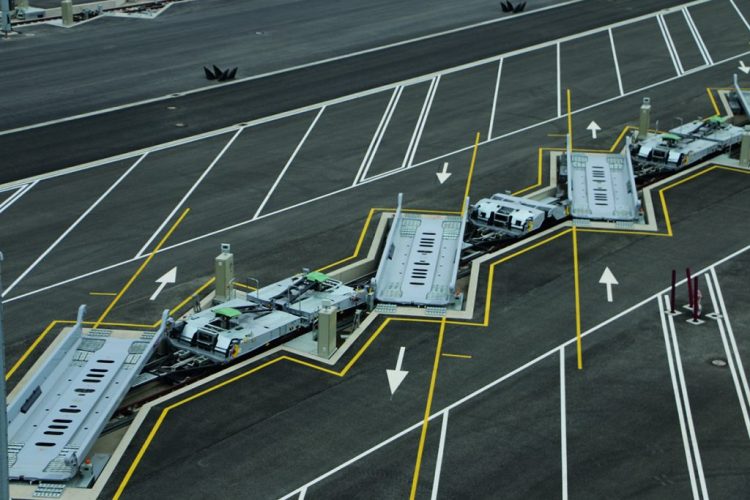Plans unveiled for 2021 rail motorway from the port of Cherbourg to Bayonne-Mouguerre
As hauliers and transport operators seek ways to reduce greenhouse gas emissions and other pollutants, Brittany Ferries has outlined plans to diversify its portfolio.
It has announced plans for an intermodal transport service for unaccompanied goods-trailers, on the rail network along the French-Atlantic coast. The company has conducted feasibility studies for a road-rail service between the ports of Cherbourg and the Bayonne/Mougeuerre area since 2018. Now the project is moving forward with partners, the aim being to launch in 2021.
What is the project?
This so-called “intermodal” project is part of a wider investment plan to secure the company’s future. It includes the transition to cleaner fuels: three new vessels will arrive over the next three years powered by Liquefied Natural Gas (LNG). This project however offers a ‘modal shift’ for freight clients, who are increasingly seeking multimodal solutions for hauliers. With the promise of lower emissions compared with transport by road.
The proposed road-rail service will complement the existing UK/Spain ‘Motorway of the Sea’ by supporting a shift from road to rail, for those moving goods between the British Isles and the Iberian Peninsula. The link represents a natural progression of the cross-Channel service to Cherbourg from both the UK and Ireland. It will support the growth of activity around Cherbourg and Bayonne and is designed to transport a wide range of trailers, including those loaded by cranes and ‘swap body’ types.
The project will anticipate regulatory challenges in the area of transport-related emissions, particularly in relation to maritime transport. But importantly, it also presents an attractive, environmentally-friendly service for shippers and hauliers. Further benefits will include reduced congestion, accidents and wear and tear on road infrastructure.
Brittany Ferries hopes to increase the share of “unaccompanied” (tractor-less) freight traffic as a proportion of its overall freight business. This share currently stands at 20% for all routes, and 25% of direct route activities between the UK and Spain. Unaccompanied freight would also halve the weight of vehicles carried, and reduce by 20% garage space on board. .
The move is also structurally linked to Brittany Ferries’ fleet plans. The more new ships come on stream, the more capacity this creates and the more opportunity to grow the service.
The route:
Rail route from Cherbourg to Bayonne: the next SNCF-Brittany Ferries steering committee, including representation from the regions of Nouvelle Aquitaine and Normandy, will decide on the possible use of the main line via Angoulême from early 2024. The studies carried out by the engineering department will be presented on 20th February. In the meantime, and beginning April 2021, the route will run via Saint-Jean d’Angély.
Cherbourg terminal:
Cherbourg is the only port on the Western Channel with the necessary infrastructure to support the creation of an efficient intermodal service. It has a working branchline leading to the port, and has sufficient space to position the intermodal interchange close to the ro-ro linkspans (ship-to-shore ramps). The port offers regular cross-Channel services, as well as links to the Republic of Ireland and Continental Europe.
Work will involve Ports de Normandie, who will be responsible for the port layout. They will also build the infrastructure necessary for the project – specifically the track and equipment needed to load and unload trailers. Financially, this will be managed by a public-private partnership.
Bayonne-Mouguerre terminal:
At the southern end of the route, the Bayonne.Mouguerre European Freight Centre is designed to handle intermodal flows bound for the Spanish Pyrenees border. The site has land, as well as facilities for trains that would meet the needs of the project. The area designated for the intermodal terminal has been selected due to its length. This will make it possible to accommodate a 750-metre-long train without impeding other activities on the site.
The technical bit:
The project will harness the Lohr, pivot-based, loading system (see image). Fixed stations at ground level will be installed. This allows railway carriages to be turned by around 45 degrees, allowing loading and unloading of standard road semi-trailers. Stations are equipped with electrical, hydraulic and pneumatics to control the movement of trailers.
The Lohr carriages accommodate standard 4-metre high semi-trailers in the UIC GB1 or AFM423. This means the service can accommodate tipper trailers, short and long tanker trailers, special glass transport trailers, flatbed trailers including those with an overrunning load up to 1.5m, as well as container trailers and car trailers.
Ends
 News
News
